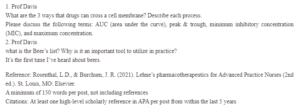Drug Diffusion and The Beer List
What are the three ways that drugs can cross a cell membrane? Describe each process.
Hello Professor,
The administration of drugs into patients’ bodies is followed by diffusion into their cell membranes. There are three main processes through which drugs can cross the cell membranes: intracellular, paracellular, and membrane diffusion (Thanuja et al., 2018). The most common form of drug distribution in cell membranes is intracellular membrane diffusion, also called lipid diffusion. Intracellular drug diffusion utilizes the high gradient of redox potential between intracellular and extracellular surroundings; the rise also exists between tumorous and normal tissues to facilitate the release of the drugs. Paracellular diffusion involves absorbing hydrophilic drugs into cells through paracellular or transcellular pathways utilizing receptor-mediated transporters. Membrane diffusion transports drugs by moving molecules with a high concentration of the drug substances to the less concentrated cell regions by diffusing through the cell membranes.
The drug diffusion area under the curve (AUC) describes the variation of drug concentration against time to explain the exposure of drugs to cell membranes and the rate at which they can diffuse into cells. In the same context, the trough is the lowest drug concentration in the patient’s bloodstream, while the peak describes the highest concentration of the drug. The minimum inhibitory concentration applies to antibiotics and represents the lowest concentration of each specific medication that can inhibit the growth of microorganisms or bacterial infections. In contrast, the maximum concentration is the lowest concentration of specific antibiotics needed to kill specific bacteria. Do you need help with your assignment ?
References
Thanuja, M. Y., Anupama, C., & Ranganath, S. H. (2018). Bioengineered cellular and cell membrane-derived vehicles for actively targeted drug delivery: so near and yet so far. Advanced drug delivery reviews, 132, 57-80.
What is the Beer’s list? Why is it an important tool to utilize in practice?
Hello Professor
The beer list constitutes guidelines for healthcare professionals to enhance safety when prescribing medications to elderly patients, typically those beyond 65, within care settings except in palliative care facilities. Initially created in 1991 by AGS, the list comprises those medications deemed inappropriate to prescribe for elderly patients (Croke, 2020). The beer list is essential in practice because it enhances effectiveness and improves medication safety when prescribing drugs for geriatric patients (Monteiro et al., 2020). Therefore, it is a tool for maintaining safe prescriptions and effective administration of medications for elderly patients and minimizes the risk of medical errors, thus enhancing care delivery.
The beer lists help care delivery for elderly patients by identifying inappropriate drugs for patients with certain conditions. It also lists medications that should be administered carefully, considering their impacts and side effects on elderly patients. It also warns about drug combinations with negative implications, plus those that should be avoided or administered in indifferent doses for patients with poor renal function.
References
Croke, L. M. (2020). Beers criteria for inappropriate medication use in older patients: an update from the AGS. American Family Physician, 101(1), 56-57.
Monteiro, C., Canário, C., Ribeiro, M. Â., Duarte, A. P., & Alves, G. (2020). Medication Evaluation in Portuguese Elderly Patients According to Beers, STOPP/START Criteria and EU (7)-PIM List–An Exploratory Study. Patient preference and adherence, 14, 795.
ORDER A PLAGIARISM-FREE PAPER HERE
We’ll write everything from scratch
Question

Drug Diffusion and The Beer List4
1. Prof Davis
What are the 3threeways that drugs can cross a cell membrane? Describe each process.
Please discuss the following terms: AUC (area under the curve), peak & trough, minimum inhibitory concentration (MIC), and maximum concentration.
2. Prof Davis
what is the Beer’s list? Why is it an important tool to utilize in practice?
It’s the first time I’ve heard about beers.
Reference: Rosenthal, L.D., & Burchum, J. R. (2021). Lehne’s pharmacotherapeutics for Advanced Practice Nurses (2nd ed.). St. Louis, MO: Elsevier.
A minimum of 150 words per post, not including references
Citations: At least one high-level scholarly reference in APA per post from within the last five years

